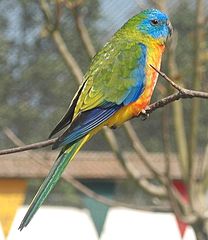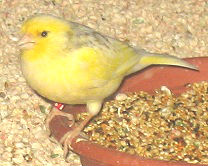Canary-parakeet hybrids
 Turquoisine Parakeet
Turquoisine ParakeetNeophema pulchella Image: Wikimedia, Stephen Jones
 Domestic Canary
Domestic CanarySerinus domesticus Image: Wikimedia
Note: Claims, such as those made in the reports cited on this page, that hybrids can actually be produced from crosses between Psittaciformes and Passeriformes, two separate avian orders, require confirmation from a specimen.
Paul Broca (1824-1880), the French physician, anatomist, and anthropologist who first discovered the region of brain governing speech (Broca’s area), also made a study of avian hybrids. In a lengthy article on hybridization in birds, he states the following (Broca 1859, p. 224):
|
|
| Budgerigars |
Tomlinson, quoted in Prestwich (1949c, p. 56), reports a similar hybrid, an alleged cross between a domestic canary and a budgerigar (Melopsittacus undulatus). He states the following with regard to a Nov. 1935 meeting of an ornithological group in southern California: “A Mr. Stone showed a bird which he claims is a cross between a canary and a Shell Parrakeet. The bird looks like a good sized green canary with the back and wings streaked with almost a buff, tail long and narrow, head and beak like the parrakeet with the heavy curved upper mandible. Of course, this is very hard to believe as the canary is of the Fringillidae family while the Parrakeet is of the Psittacine family.”
Indeed, Tomlinson understates the disparity between the parents alleged in this cross (and in the cross described by Broca above). It would be interordinal, not interfamilial, since parrots and parakeets belong to Order Psittaciformes while canaries are assigned to Order Passeriformes. However, a taxonomic arrangement recently proposed by Suh et al. (“Mesozoic retroposons reveal parrots as the closest living relatives of passerine birds,” 2011) does group these two orders together under the name “Psittacopasserae.”
Another avian interordinal cross >>
By the same author: Handbook of Avian Hybrids of the World, Oxford University Press (2006).
Most shared on Macroevolution.net:
Human Origins: Are we hybrids?
On the Origins of New Forms of Life
Mammalian Hybrids
Cat-rabbit Hybrids: Fact or fiction?
Famous Biologists
Dog-cow Hybrids
Georges Cuvier: A Biography
Prothero: A Rebuttal
Branches of Biology
Dog-fox Hybrids